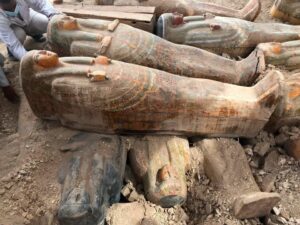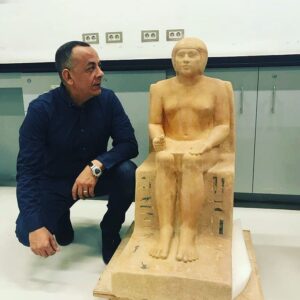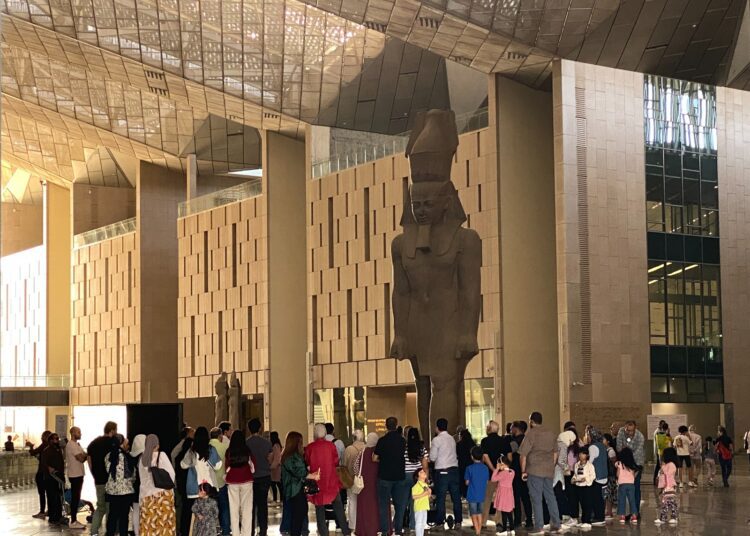No greater accolade could be made except by the American weekly magazine Time (March 16, 2023), which listed Giza as one of the great tourist destinations with the must-see Grand Egyptian Museum (GEM) near the Pyramids Plateau and the go-to place for more antiquities: Saqqara.
For the first time ever, the entire collection (5,000 items) of Tutankhamun treasures, discovered in 1922, will be on display at the GEM, plus thousands of artefacts that have never been seen before in public.
The Time mentioned the museum halls that the visitor will enjoy when it opens. It reviewed some recent Egyptian-made archaeological discoveries.
Now the Egyptian Mail looks at those artefacts unearthed in recent years by the Egyptian archaeological mission led by the Supreme Council of Antiquities secretary general Mostafa Waziry.

In October 2019, the Tourism and Antiquities Ministry revealed at an international press conference what it called the “biggest and most important” discovery since the end of the 19th century, namely of 30 wooden coffins in the Assasif Necropolis on the west bank of the Nile near Luxor.
The coffins are in excellent condition with the paint intact.
The coffins, which had been collected and concealed to prevent looting, had been placed in two layers: 18 coffins on top of 12 others for men, women and children of the XXII Dynasty (943 BC-716 BC). The coffins are on display in a hall named Assasif Cache.
In March 2022, five tombs were found in south Saqqara, 100 metres northwest of the Merenre Pyramid of the VI Dynasty of Old Kingdom (ca. 2345 BC-ca. 2181 BC).

Prussian Egyptologist Richard Lepsius excavated this area in the 1840s when he uncovered part of the Merenre Pyramid and then stopped. In 1881, French Egyptologist Gaston Maspero found the rest of the pyramid and a coffin, which was believed to be from some later burial, although some modern scholars now think it was the mummy of Merenre after all. If so, that would make it the oldest-known royal mummy. Whatever the case, the mummy is currently on display at the Imhotep Museum in Saqqara, which is due to open soon.
Maspero said that after 100 metres away from the pyramid there was a tomb for someone called Iart. He didn’t give details, according to Waziry.
“In September 2021, we found the tomb and other four tombs dating back to the end of the Old Kingdom and the beginning of the first intermediate period,” Waziry said.
Three of these 4,000-year-old tombs for Henu, Iart, and Bebi Nefer who served as senior officials and palace supervisors, will be displayed at the GEM.
The tombs, which had been seven-metre-deep burial shafts, are highly decorated and appear as if they had been painted yesterday. Colours vary between red, yellow, blue, black, white and green. Several wooden figurines and small pots in basalt and limestone were found in the tombs.
The tomb walls bear funerary scenes with an offering table, the facade of a palace, and depictions of alabaster jars with the Seven Sacred Oils, which were used in mummification.
On May 30, 2022, the mission unearthed a cache of 150 bronze statues of gods and goddesses in the Bubasteion cemetery at the Saqqara necropolis, southwest of Cairo, dating back to the Late Period (c. 664 BC–c. 332 BC), plus 250 sealed wooden coffins, rich in detail and containing mummies.
Inside one of these coffins was a 16-metre-long papyrus in good condition with chapters from the Book of the Dead, which can be seen at the Egyptian Museum in Tahrir, downtown Cairo. The papyrus is named after Waziry.

There is also the seated statue of Itisen, son of a king. This sandstone statue, unearthed at Abu Rawash archaeological site, 8 km north-west of the Giza plateau, dates back to the IV Dynasty of the Old Kingdom (c. 2613 BC-c. 2494 BC).
The GEM is currently open for limited tours before the grand opening of the museum, of which the date is yet to be announced.
Tours, which can be booked only online, include the gardens, the commercial area with big-name Egyptian brand stores, restaurants, cafeterias, and the gift shop.
Visitors have access to the Hanging Obelisk area and the main reception hall, or Grand Hall, where the statue of King Ramses II, the victory pillar of Pharaoh Merneptah and two statues of a king and queen from the Ptolemaic era are on display.
On April 30, Japanese Prime Minister Fumio Kishida accompanied by Prime Minister Mostafa Madbouli and Waziry visited the GEM, which he described as symbolic of cooperation between the two countries. Egypt and Japan began working on the GEM in 2006.






Discussion about this post